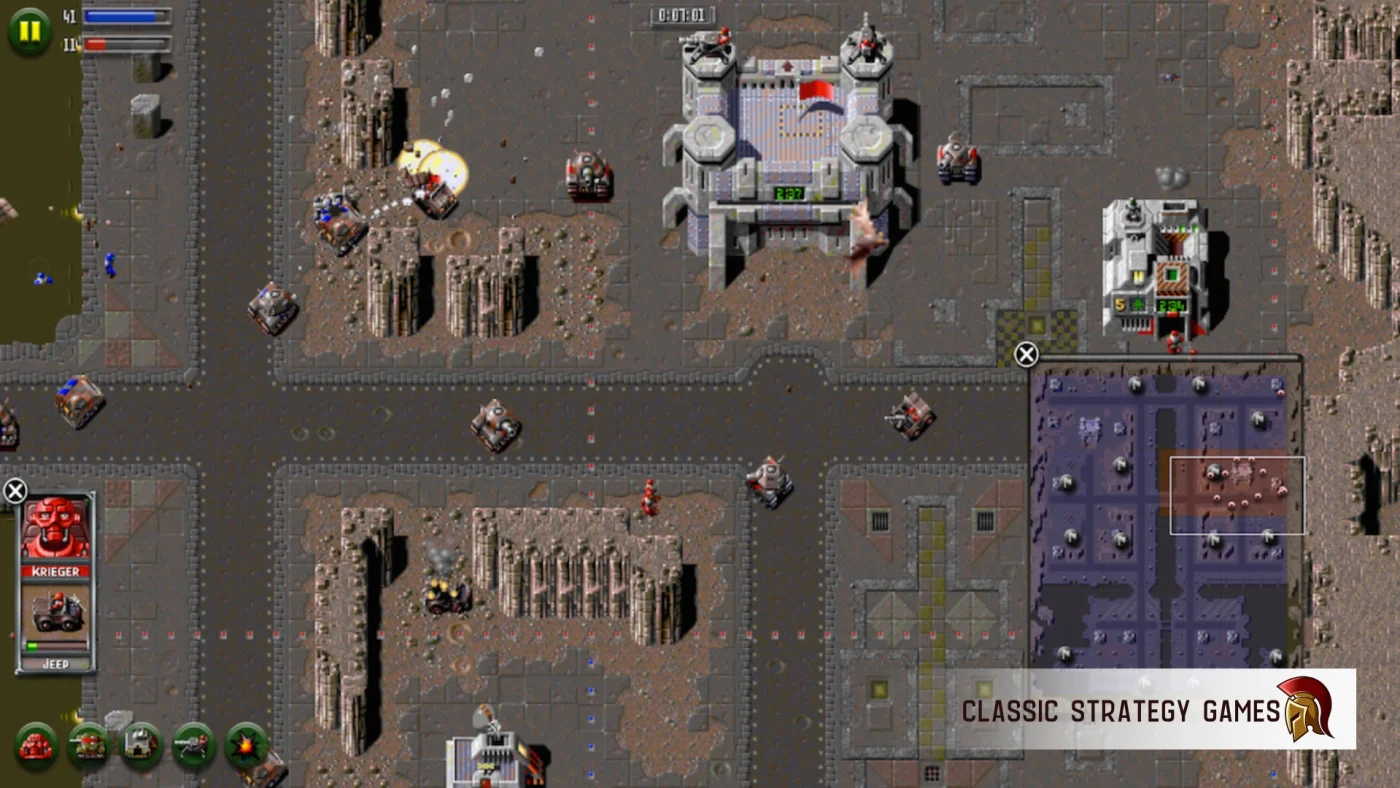Released in 1996 by The Bitmap Brothers, Z (pronounced “Zed” in the UK) was a unique and bold entry in the real-time strategy genre. Departing from the standard RTS formula of base building and resource management, Z emphasized fast-paced, territory-based gameplay with a heavy dose of humour. Set in a futuristic, industrial world, the game cast players as the commander of a robot army engaged in a brutal war for dominance against a rival AI force. Its distinctive style, irreverent tone, and unconventional mechanics gave Z a character all its own, cementing it as a cult classic among strategy fans looking for something different.
A Fresh Approach to Territory Control
Z broke away from traditional resource-gathering mechanics and instead centred on controlling territories. Players started each mission with a single command centre and a handful of robots, tasked with capturing and holding zones across the map. Each territory featured a factory that produced either vehicles or reinforcements, with production speed tied to the number of zones controlled. The more zones players captured, the faster they could build up their forces. This shift from harvesting resources to direct territory control created a fast-paced, dynamic style of play that emphasized aggression and quick decision-making.
The game’s emphasis on territory meant that players were constantly pushed to expand and hold ground rather than settle into a defensive posture. Each territory provided valuable reinforcements, rewarding players who could seize and hold key areas. This shift in focus also reduced downtime, as players were always fighting to capture or reclaim territory, leading to an intense, action-driven experience where the tide of battle could change rapidly.
Robot Soldiers with Personality
One of Z’s most memorable features was its cast of robot soldiers, each with a unique and irreverent personality. The game’s humour shone through in the banter between units, with robots making sarcastic comments and complaining about the difficulty of their missions. Far from the emotionless units typically seen in strategy games, these robots had a comedic edge, reacting to orders, celebrating victories, and lamenting failures. This humorous approach gave Z a distinctive charm and provided a light-hearted contrast to the intense battles, making the game feel as much like a parody of warfare as a serious RTS.
The robots in Z weren’t customizable, and there was no way to directly improve their abilities, which meant that success depended on tactical use of terrain and unit placement rather than upgrading units or investing in technologies. This design choice made the game feel raw and challenging, with every victory achieved through skill and strategy rather than sheer numbers or unit upgrades.
Strategic Challenges and High Difficulty
Despite its humorous tone, Z was known for its high difficulty level and unforgiving gameplay. The AI opponents were relentless, often capturing territories and amassing forces with alarming speed. Because the game lacked a traditional resource system, players had no way to “out-economy” their opponents; they had to win through tactical skill and careful positioning. This focus on pure strategy created a challenging experience that demanded constant awareness and quick decision-making.
The game’s maps were carefully designed, with choke points, elevated positions, and destructible bridges that could be used to gain an advantage. Holding these strategic positions could turn the tide of battle, but losing control of a key area could quickly spell disaster. This map-based strategy added a layer of depth, forcing players to think critically about how to approach each map and plan their moves carefully.
Visually Distinct and Humor-Driven
Z stood out visually, with its detailed, industrial environments and cartoonish robot designs. The art style blended futuristic war machines with gritty landscapes, creating a setting that felt both harsh and exaggerated. This distinctive visual presentation was complemented by the game’s soundtrack, which featured an upbeat rock score that added to the game’s irreverent tone and kept the pace high. The visuals and music worked together to create an atmosphere that was gritty yet fun, capturing the game’s unique mix of humour and action.
The humour extended beyond the robots’ banter, as the game included cutscenes between missions that advanced the story and provided comedic context to the battles. These short scenes featured the player’s robotic adversaries in various humorous scenarios, adding to the game’s quirky personality and helping to make each mission feel like part of an ongoing narrative.
Legacy of Z
Z was a refreshing twist on the real-time strategy genre, offering a streamlined, action-packed alternative to the more methodical, base-building-heavy games of its time. Its focus on territory control over resource management, its distinctive personality-filled units, and its challenging gameplay earned it a dedicated following. Although Z was not a massive commercial hit, its uniqueness and bold design left a lasting impact on the genre. The game’s unconventional approach showed that real-time strategy could be flexible, incorporating humour, fast pacing, and dynamic combat without sacrificing strategic depth.
In later years, Z received several updates and re-releases, including a remastered version for modern platforms, ensuring that new generations could experience its distinctive gameplay. For fans of classic strategy games, Z remains a noteworthy and influential title that captured a spirit of innovation and playfulness, proving that strategy games could be as fun and light-hearted as they were challenging.


